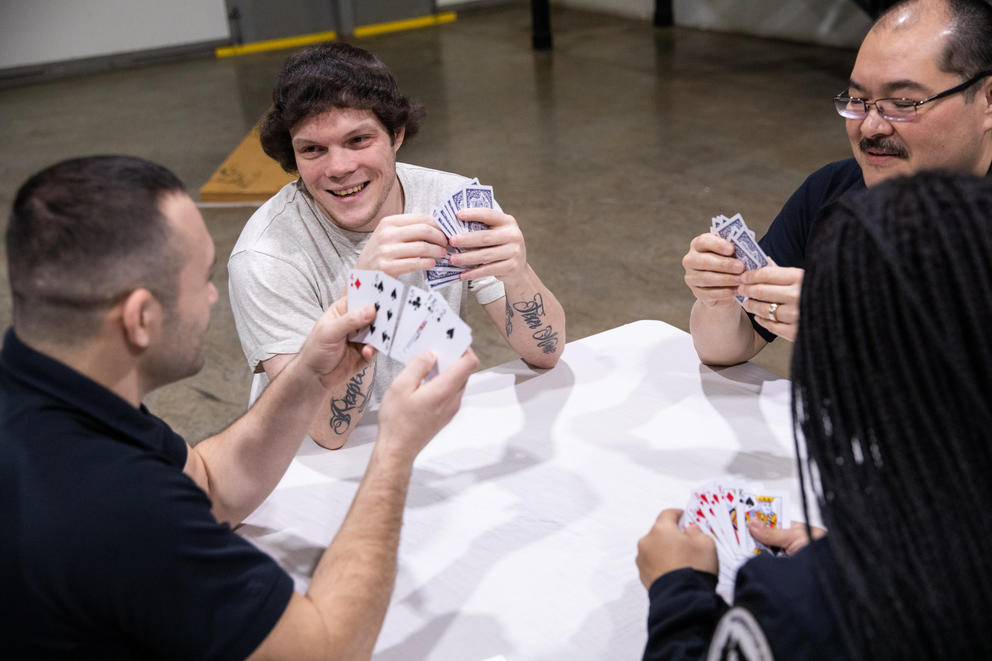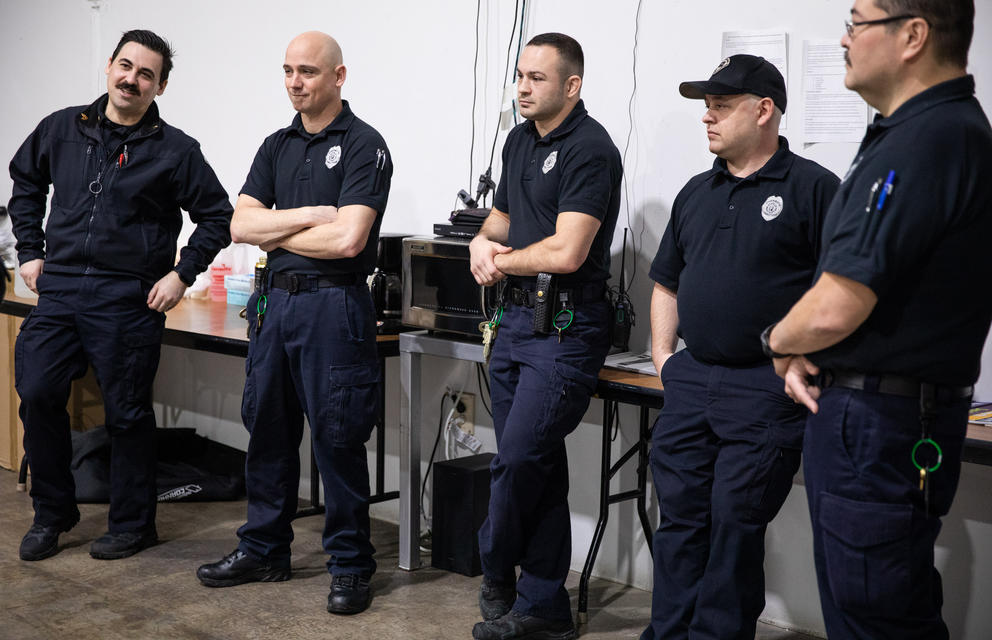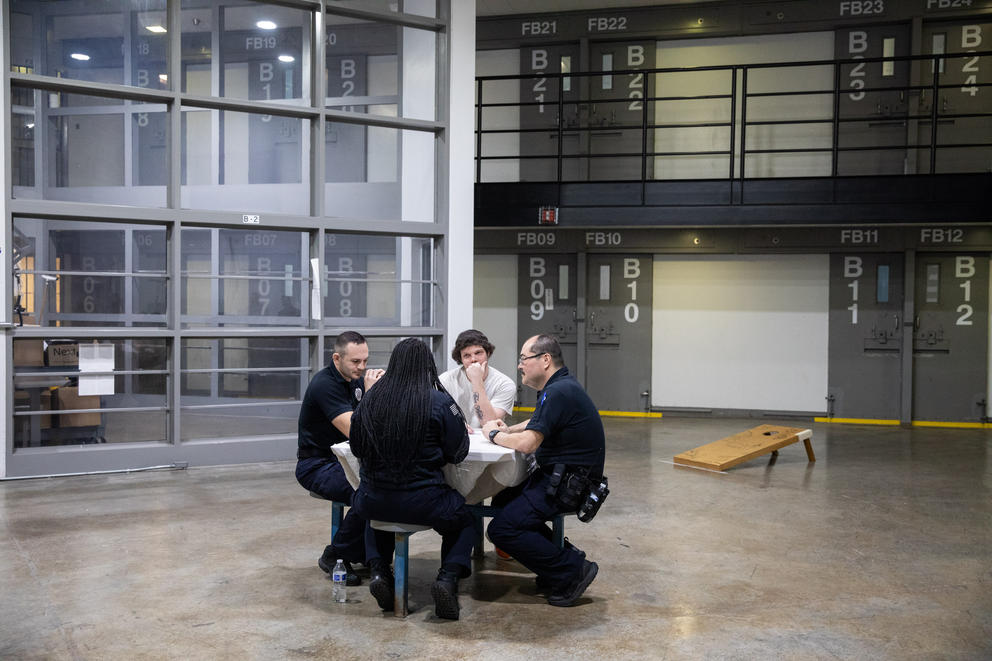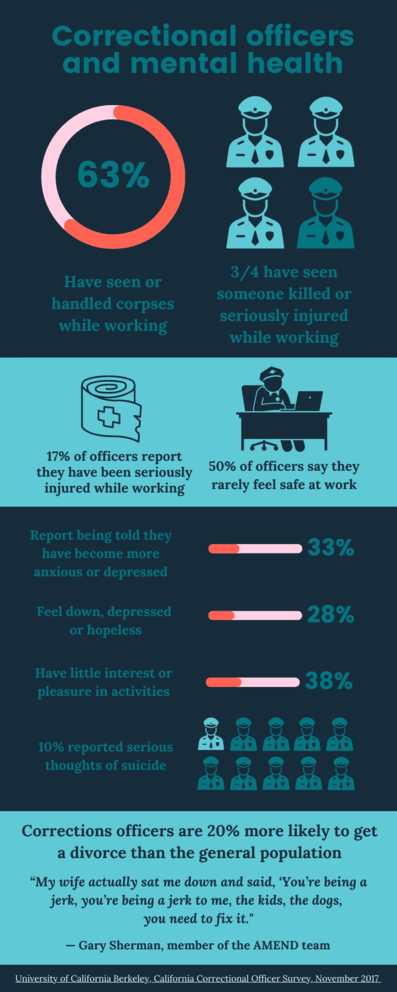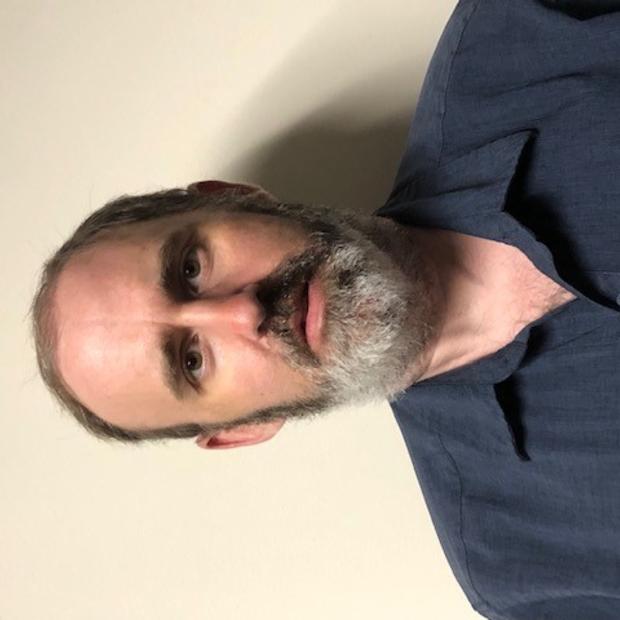Not far from the table, a pair of cornhole boards bracket the ends of the open floor plan. A basketball hoop is affixed to the wall. A black metal bookshelf with educational volumes pairs with a longer folding table against the wall, where hot coffee awaits. The Mamas & the Papas classic “California Dreamin’” echoes off the high concrete ceiling.
This isn’t just any social hour: It’s a pilot project for Amend, a program reshaping how people are treated inside prisons based on Norway’s experience in creating more humane conditions. The aim is to bring more human interaction into the lives of those inside, to get them ready to function better once they return to society.
The Amend program, a public health and human rights program run out of the University of California San Francisco, is also being tried in California, Oregon and North Dakota.
The program isn’t only trying to better prepare incarcerated individuals to return to society after they serve their sentences. Researchers and corrections officials say that more humane treatment also lowers the stress and traumas of corrections officers, who themselves frequently encounter violence and threats inside prisons.
To do that, the Department of Corrections hopes the program will lead to reductions in use of force and assaults among staff, as well as less violence among those inside, and fewer uses of solitary confinement.
Crump and the officers he’s playing cards with are part of an experiment that state corrections officials hope to expand more broadly across Washington’s 12 prisons. At the request of the Washington Department of Corrections, Gov. Jay Inslee has included $12.7 million in his proposed two-year state budget to hire 52 more staffers for the Amend program. It’s part of a larger push to reshape the culture of how prisons operate and how corrections officers interact with those inside.
The push for this cultural change also comes as corrections officials continue to wrestle with a decade of festering crises within Washington’s prisons. Lawsuits, independent oversight reports and news coverage have documented the inadequate health care given to incarcerated people, an antiquated system of paper medical records, chronic staffing shortages and a computer database that still can’t correctly calculate prison sentences, nearly 10 years after corrections officials announced it was broken. In recent years, state regulators have fined the Department of Corrections for health and safety violations at Stafford Creek during both the COVID-19 pandemic and a tuberculosis outbreak.
Perhaps the biggest obstacle to implementing Amend is convincing corrections officers to take a different approach with their quarry and leave behind older ideas on how incarcerated people should be treated inside. That includes skepticism about changing or relaxing security practices, which is one aspect of Amend. The program emphasizes a concept called “dynamic security,” defined as “frequent, effective, and respectful communication between correctional staff and prison residents,” according to the project’s foundational principles.
In a statement to Crosscut, Teamsters 117, which represents Washington’s prison guards, touched on some of those concerns. Treasurer John Scearcy said the union supports “programming that helps prepare incarcerated individuals for life after prison.”
“This cannot come, however, at the expense of staff safety and the safety and security of the incarcerated population themselves,” Scearcy continued. “The chronic staffing shortage that currently plagues DOC has led to excessive mandatory overtime and to dangerous understaffing in critical parts of the prisons. DOC needs to prioritize the staffing crisis so that prisons are safe for everyone.”
Corrections Officer Eric Garcia was also skeptical about the Amend program at first. He worried it would make the officers less safe: “It was kind of difficult to get behind.”
Garcia started his career as a corrections officer after a paper mill where he worked shut down. It took him a while to warm to the idea of Amend, which included visiting prisons in Norway, as well as in California and Oregon where Amend projects are also moving forward. In Norway, Garcia was struck by the amount of interaction that officers had with those inside, just talking. “I’m not going to lie, it was definitely weird,” he said.
Now Garcia leads the five-member Amend team at Stafford Creek. And he describes himself as a believer.
Steps toward the wider world
Crump, 31, is nearing the end of a 10-year prison sentence for charges that include kidnapping, assault and use of a controlled substance, according to the Department of Corrections. Set to be released in December, Crump says he’s used this time with the officers to also talk about what he needs to get started in construction and remodeling work.
"With the information they've been able to provide me, just with different carpentry programs, different union programs, it's really been helpful for me, for, like, my release when I get out,” Crump said. “It's been a big advantage."
Before transferring a few months ago to Stafford Creek, Crump said he spent most of his time behind bars at the Washington State Penitentiary in Walla Walla, including in a maximum-security wing. He sums up the isolating experience that officers and researchers say is bad for people expected to return to the wider world: “Working out in the morning, sleep until lunch, someone comes by and drops off lunch, then you sleep some more and work out some more.”
Crump likes this social time — roughly two-hour sessions a couple times a week — because it also gets him away from the banging, yelling and singing of his cellmates.
“Think about being in one of those little rooms right there, and you got somebody next to you that’s just banging on their door for nine hours, you know what I mean?” Crump said.
“We’re having a conversation here, this is normal,” he added. “That’s not happening back on the tier.”
As the interview wraps up, Crump extends an invitation to come see where he lives. It’s a short walk down a hallway to the intensive management unit, a bank of two dozen cells laid out similar to the Amend room, each with a narrow vertical window about two-thirds the way up their metal doors. The officers, after a moment of consulting, say it’s OK to visit, and Corrections Officer Charles Cook walks a reporter and a photographer over to the cell.
Cook, who moved to Washington long ago, still speaks with a distinct Maine accent. Walking down the hall, he talks about how difficult it can be to get individuals who have been isolated for a long time accustomed to being around people again.
“When you’ve been isolated or away from everybody, you’re a little touchy about being around one or two people,” Cook said.
Our little tour group is noticed almost as soon as we set foot in the unit. From the quiet, shouting and singing emerges. One cellmate belts out a full rendition of “The Star-Spangled Banner.”
Fengsel is Norwegian for prison
Washington’s partnership with Amend began in autumn 2020, although the pandemic slowed its rollout.
But by then, prison officials had already chosen Stafford Creek Corrections Center — which holds nearly 2,000 people — as a good place for a pilot project. The facility is nestled deep in the forests in Aberdeen, Grays Harbor County. It houses a mix of maximum-, medium- and minimum-security individuals; that variety is one reason prison officials chose it early on for the Amend project.
A couple hours before the interview with Crump, Morten Roer and Linda-Catherine Hansen walk into Stafford Creek wearing uniforms that bear the word Fengsel, Norwegian for “prison.” It’s Roer’s first visit to an American prison, though Hansen has made a few previous visits to Amend projects in other states. Today they get a taste of a classic Western Washington winter – it’s about 45 degrees with a heavy blanket of clouds that erupt into hammering sheets of rain.
The visitors have come along with Cyrus Ahalt, who is Amend's chief program officer for the University of California San Francisco.
One of the Norwegian officers’ tasks today is to job-shadow corrections staff in the prison’s general population to discuss a potential Amend project there. That’s a different wing of the prison, where inmates have keys to their own rooms and can mix during the day in a large hall. Roer will discuss the concept of introducing “contact officers” for the general population. That is a different type of Amend staffer than the current team working in the higher-security area. Here in the general population, a contact officer would be assigned to a small number of incarcerated people to keep in touch, prevent problems and support their successes.
Unlike in the United States, almost all incarcerated people in Norway are ultimately released, Roer said, which got officers thinking more about how to rehabilitate those who will rejoin society.
“And we started to say, ‘What kind of neighbor do we want to have?’” Roer said. “And that’s the idea, we have to be safe when they're inside and we have to create an environment [so] that the inmates can have some skills they can use outside.”
The visiting officers are also clear-eyed about the challenges of changing the culture among corrections workers.
In Norway, “It took about 10 years for a contact-officer system before everybody was on board,” Roer said as he sits in a conference room outside the prison’s secure areas at the beginning of the day.
Roer also emphasizes another aspect of the program in Norway that makes it unique: a bottom-up approach that prioritizes listening to both incarcerated people and corrections workers.
That is on display when Crump enters the room for cards later in the day without restraints. Garcia’s team has been looking for ways to boost the normality of interactions, and on some inmates they trust they’ll remove leg or hand restraints or both. But doing that also meant reworking their policy on how they transport an incarcerated person from their cell to the big room.
Seeking more humane conditions for officers
Another member of the Amend team at Stafford, corrections officer David Gleeson, has been gathering books and educational material for the Amend team’s bookshelf in the big room. Some are GED manuals and instruction books on math and reading; others are informational brochures on how to get a driver’s license.
In the duality of life as a corrections officer, Gleeson casually switches between the rehabilitative work he’s trying to do and the trauma he has suffered inside.
Gleeson had his meniscus torn during an altercation with an inmate, he says, and has been headbutted so hard he thought he got a concussion. He’s had to go to the hospital to care for infections related to having a “milkshake” — a cup filled with a mixture of urine, excrement or semen — tossed at him.
This is the other side of Amend: the quest to create more humane conditions for corrections officers.
A 2017 survey found that more than half of California’s 8,334 corrections officers and other staff described violent incidents as regular occurrences at their prisons.
In that survey, conducted by the University of California Berkeley, 80% reported having responded to at least one violent incident in the past half year, and 10% reported being seriously injured.
In all, 17% of correctional officers report they have been seriously injured while working; 63% have seen or handled corpses while working; and nearly three-quarters have seen someone killed or seriously hurt while working.
A 1997 study, meanwhile, concluded that corrections officers have a 39% greater risk of suicide than the rest of the working-age population. An even older national study, from 1984, suggested that corrections officers had a life expectancy of 59 years, 16 years short of the general life expectancy at the time.
A regular work environment like that shapes the culture. Gleeson describes an “old-school” generation of corrections staffers who don’t feel as understanding about attempts to rehabilitate those inside.
And he too can look back at earlier points in his 19-year career where the work stress boiled over: “I’m having a yelling match with a guy behind a door, unnecessarily, over nothing.”
“It just took littler and littler stuff for me to snap at an incarcerated individual,” he said.
Likewise, another member of the Amend team, Gary Sherman, said he would come home and play video games for an hour to decompress before seeing his wife and kids.
“My wife actually sat me down and said, ‘You’re being a jerk, you’re being a jerk to me, the kids, the dogs, you need to fix it,’” Sherman said.
Having more autonomy at work and the rehabilitation process of being on the Amend team have changed that, said Sherman, the team’s assistant leader.
“It was just the way that we’re working is a little different,” he said. “And I didn’t need the decompression anymore.”
Self-isolation isn’t good for anybody
The Amend officers acknowledge that progress can look dauntingly incremental.
Some incarcerated people won’t come out for social time because prison gangs can have a rule about not talking to a correction officer without another inmate present, according to Sherman and Gleeson. That’s a rule designed to make sure the incarcerated person isn’t feeding information to a corrections officer.
The Amend officers also talk a lot about trying to get individuals inside the intensive management units — meaning they have their own cell — out into the general population units.
After Crump is taken back to his cell, the team brings in another individual: an older man, a veteran with long gray hair. The man takes a seat where Crump had just been; an officer brings in a service dog to say hello.
The officers have been trying to get this man comfortable with leaving his cell, said Corrections Officer Nathan Stolen, the fifth member of the team. He has been alone for many years, said Stolen, who leaned against a guard post outside the room as he told the story. So much isolation combined with fears of violence can make it hard for some to want to be back out around people.
In one attempt to build a connection, the officers were able to get a copy of the man’s DD-214, or military discharge record; Stolen says the man had never had a copy of his own records.
“Being in self-isolation is not good for anybody, whether they choose to be there or not,” said Stolen. But: “It’s all on his own choosing, we don’t make anyone do anything.”
In other cases, the officers might get an individual out of the intensive management unit and out into the general population, says Cook, but they wind up coming back to their higher-security cell. He describes the progress as “baby steps.”
Garcia, Gleeson, Stolen, Sherman and Cook have more ideas for Amend. Gleeson is planning a garden that will be just outside in an enclosed area that houses a regulation-height basketball hoop. The garden is an idea pushed by the team, and DOC found funding for it. Gleeson talks about it as an opportunity for Amend participants to experience feeling grass, and maybe to grow fresh strawberries and blueberries.
Now that he’s a father, he says he thinks differently than he did earlier in his career.
“In my head it comes down to making better neighbors,” he said. “It comes down to a better society.”
Listen to reporter Joseph O’Sullivan discuss this story on the Crosscut Reports podcast:

